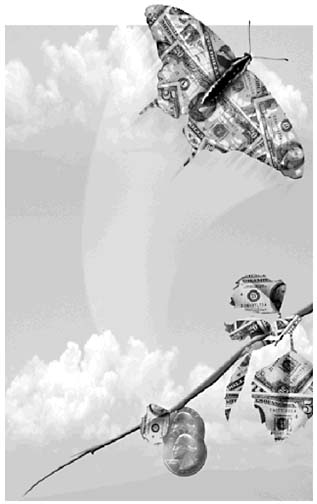

A forum for Hawaii's
business community to discuss
current events and issues
» Born to fly
» Help open door to building education
BACK TO TOP |
[ CREATING EXCELLENCE ]
BRYANT FUKUTOMI / BFUKUTOMI@STARBULLETIN.COM
Born to fly ... other
transformations in action
You might want to be a bit more careful as you go about your daily life. Otherwise you may inadvertently bring an early end to one of nature's many transformations, one full of lessons for organizational leaders. For up ahead might be a very slow moving, currently earth bound, multilegged creature we'd all recognize as a caterpillar. If this ponderous, relatively unattractive "seed of an idea" doesn't get prematurely "squashed," we may next see it safely ensconced in a protective cocoon, its home for the next phase of its transformation. "What can this miracle of nature teach us about organizational transformation?" you wonder.
One vitally important set of lessons has to do with the fact that transformations have their own underlying rhythms and paces. We must be patient and humble as this pace unfolds. Imagine yourself watching the butterfly struggling, oh so very hard, to break free of its constraining walls. In a well-intentioned but misguided attempt be of help, you might reach out and make a little puka to help it along. And, in so doing, you may have inadvertently assured that the butterfly does not grow to its fullest potential. You may even have put it in jeopardy of an early demise.
Why? Because it is in the very process of pushing itself out into the real world, where it must be able to cope and survive without the warmth and protection of its womb-like cocoon, that a butterfly develops the wing strength to soar.
When we work out on weights in the gym, we are using resistance to get stronger. Similarly, organizational resistance to a transformational idea or process is not, in and of itself, a bad thing. The challenge is turning this resistance, which, again, is a natural aspect of any major transformation, into a positive force. One that strengthens the organization's heart and soul for the journey that lies ahead. Indeed, looked at from this perspective, leaders should be suspicious of the total absence of any resistance.
But perhaps the greatest challenge that this natural and positive phenomenon of resistance carries, lies within a transformational leader's own heart and soul. We need only look to the one transformation that each and every one of us has personally experienced in our lives to prove this point -- our own birth. Or, better yet, since we have no conscious memories of our own births, having been present when our own child was born.
There is a period during the final stages of this miracle of all miraculous transformations that the medical profession labels as "transitional pain." During this period, if the mother has chosen to be awake and un-medicated, the following scenario would be typical. One the one hand, mother and father are about to experience one of life's most joyous transformations -- one they may have wanted, planned for and prayed for. On the other hand, the mother is screaming and yelling blasphemous obscenities at her doctor, the nurses and even her husband, her partner in creating this transformation.
There comes a point in many organizational transformations that brings with it similar dynamics. Even though there was excited consensus on the value of beginning the transformational journey. Even though there was equal enthusiasm as the emerging transformation began to take visible shape. When the actual time comes for the transformation to "be born," natural second thoughts should be expected. These will range from relatively simple questions like: "What did we get ourselves in to?" to much more intense angry outbursts: "How could you lead us into such a painful place?!" The later are invariable aimed at the "father" or the "mother" of the idea.
To be the leader of an organizational transformation requires the skill and attitude of a mid-wife, the ability to be with another's pain while being fundamentally helpless to do anything about it. Facing this pain is difficult. Consequently, many leaders during this period of transformation bury themselves in their offices behind mountains of computer printouts. Compassion, empathy, humility and faith -- not data -- are what is needed at this time.
All organizational transformations, as we noted in an earlier article, involve major organizational changes, but all organizational changes are not associated with transformations. As we shall see in the next and final article in this series, compassion, empathy, humility and faith are the building blocks for all meaningful personal transformations. And organizational transformations are, at their fundamental cores, personal transformations.
Irwin Rubin is a Honolulu-based author and president of Temenos Inc., which specializes in executive leadership development and behavioral coaching, communication skill building training, and large system culture change. His column appears twice a month in the Honolulu Star Bulletin. Send questions and column suggestions to temenos@lava.net or visit temenosinc.com.
BACK TO TOP |
LetŐs help open door
to building education
I've attended several functions recently, including the Jobs Outlook forum in January, where the availability of future construction labor was the primary focus of debate. Two suggestions that I proposed seem to move forward. The first proposal would assist in growing the labor pool out of our resident youth.
My idea was recently discussed with some Associated Builders and Contractors business associates, contractors and a few state employees. As of this date, there have yet to be any negative doomsayers ready to squash this simple concept.
Early recruiting
The employment model that I'm asking you to consider is that the state Department of Labor, along with our state Apprentice Council, should allow 17 year olds -- juniors and seniors who are still in high school -- to have the ability to work half days in non-hazardous environments within the construction industry.Historically, some erroneous assumptions have been made concerning youthful employment and safety within the industry and, true to bureaucratic form, unapprised policy-makers turned internal opinions into a set of rules.
Currently, thousands of Hawaii high school students graduate at the age of 17. Most, if not all, construction jobs are not open to any persons under the age of 18. Because of the 1-year separation, the construction industry losses what I believe is the most important window of opportunity for the youth that have no real intention of going off to college.
Easy implementation
The logistics of this type of program would be easy to work out. Student evaluations would be based on their performance and could be part of their academic grades and selected as an elective with their particular school. The hours worked would also be credited to any future apprenticeship program that they may enlist in. Earnings would be based upon the pre-apprentice wage scale of their particular employer(s).With such a state-wide program, co-sponsored by the Department of Education and with the support of the industry, many of these students would be able to flow into a trade without a period of "dead time." The student would be able to experience a seamless entry into apprenticeship programs already existing throughout this state. This move would lessen any associated educational budgeting issues since the existing formats are in place.
I ask, what other educational tool would impact so many with such a small cost? Any other new program, bent on the wholesale education of this select group, would not get the same bang for the buck.
I would hope that such a simple program could be instigated by our leadership with very little effort. It is clear that such a program, one that would be addressing the further education of our teens during their most formative years, would be enormously popular with students and parents alike.
By Robert Hugh Joslin lives in Wailuku, Maui, and is chairman of the board of the Associated Builders and Contractors, Hawaii.
To participate in the Think Inc. discussion, e-mail your comments to business@starbulletin.com; fax them to 529-4750; or mail them to Think Inc., Honolulu Star-Bulletin, 7 Waterfront Plaza, Suite 210, 500 Ala Moana, Honolulu, Hawaii 96813. Anonymous submissions will be discarded.
